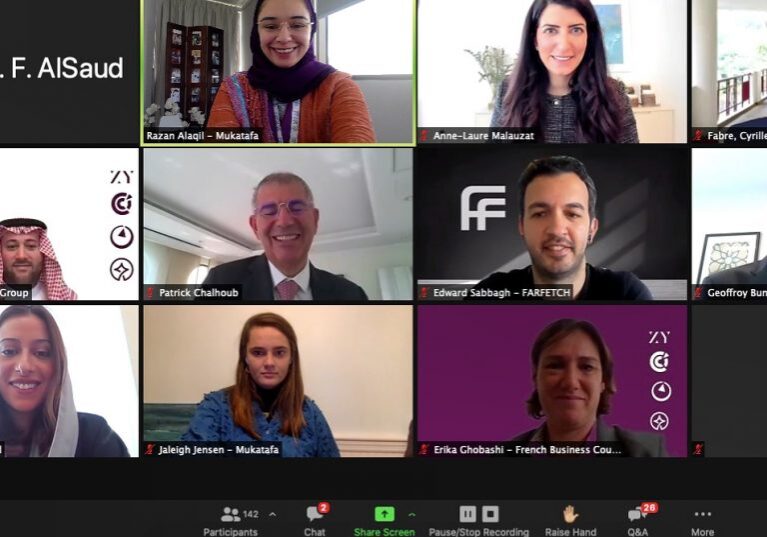Luxury Goods Market GCC 2020-2021 Webinar
Our first Zarqaa Event
As we have transitioned to living in this pandemic for nearly a year now, all events have looked different. Our first Zarqaa Majilis event was no exception. As we joined global consultancies from all corners of the world, we were humbled that nearly 200 brilliant attendees could be virtually present with us.
Thank you to our esteemed panelists, Her Highness Noura Bint Faisal Al Saud, Mr. Patrick Chalhoub, Mr. Edward Sabbagh, and Mr. Faysal AlMalki, for your involvement and insight as panelists. You all truly exemplified how the public sector is enabling the private sector’s growth in the Saudi luxury goods market.
Thank you to Mr. Cyrille Fabre and Ms. Anne-Laure Malauzat from Bain & Co. for your presentation on the Luxury Goods Market in the GCC 2020-21. Your presentation allowed direction for how we can set the trajectory for this year.
And thank you to ZY Association and French Business Council for being our partners in hosting this event.

As demonstrated in their Luxury Goods Market in the GCC 2020-21 study, Cyrille Fabre and Anne-Laure Malazat from Bain & Co. showed that while 2020 proved hardship, humans proved resilience. It has been a challenging year for so many global markets, especially the luxury market, but now we are starting to see the light at the end of the tunnel. Where the market fell short in 2020, 2021 is projected to prove growth that is only shadows behind 2019.
And the driver of this economy is Saudi. This is especially highlighted in KSA and the local markets, where the Luxury Goods Sector is predicted to increase by 110% from 2020 to 2021.

But with the impacts of COVID-19 still holding strong, this study proved that e-commerce and digital marketing are the most important investments for paving the market route. Especially in matters of mobile marketing. Malazat said,
“The key is to focus on mobile for brand noticeability — e-commerce should be used at every stage of the funnel, not just discovery.”
When companies are strategizing their approach to all industries and markets, Malazat reiterated the importance of communications and marketing approaches to engagement with your consumers. Because even in a world that has evolved into being all the more distanced and digitized, the power of connection is still in the palm of our hands.
You can view the entire recorded presentation here.

In reflection of these points, among many others, our panelists had much to converse with notes given their own experience in the Luxury Goods sector. Likewise, this panelist discussion was widely led by the need for e-commerce and digitization with specific lenses into the demographic of the consumer.
As the representative of KSA’s Ministry of Cultures Fashion Commission, Her Highness Noura Bint Faisal Al Saud began this conversation and gave scope into the key components of the Luxury Goods sector strategy in order to further this community’s growth. Her Highness said,
“We, as a commission, look at the industry thriving across the whole value chain. So in creating opportunities for research and development, raw materials and manufacturing, retail storytelling and narrative, and sustainability, we are overriding the luxury goods industry’s enablers.”
And, in adjusting and innovating beyond COVID-19, she urged everyone to continue to look at their own problems with digital solutions.
“How can our business models be more sustainable, more inclusive, so that is the vision of Saudi can be achieved and we can continue to lead when it comes to sustainability innovation and digital practices.”
“So for us as retailers it means to reinvent ourselves, to reinvent our brick and mortar in order to give a fantastic experience but also this human connection… So one of our challenges with the e-commerce site is to maintain this drive for the e-commerce but also to give the right hybrid experience to our customers online and offline.”
Edward Sabbagh, Managing Director Middle East at FarFetch, continued this chain of thought with his experience with managing the largest online luxury platforms. In looking at demographics pertaining to age and correlated interests, he expanding on the social commerce of the region and how it related to e-commerce. In giving an example about the importance of social media in e-commerce he said,
“A fun fact for Farfetch is that our highest daily visitors that ever came to Farfetch was not on Black Friday, it was on the latest release of the off-white Nike sneaker. So if you can just understand the social bots out there, the second you post, the viewership is going to come.”
“The Saudi population is very young, about 48 percent of the population is under 25 and maybe 70 percent is under 35. And they’re extremely connected, like my colleague Edward said, on every social media platform you can think of… And therefore the Saudi consumer wants the same product that is offered somewhere else because they usually go to London or Paris to buy it, but we have to provide the same level of service through e-commerce.”
Through the link here, you can view this panelist discussion along with our event’s entire recorded presentation, including the study from Bain & Co. We welcome you to reflect on how you can be involved in the cross-sectoral collaboration between the private and public sectors this year.
Because while the pandemic slowed our progress from 2019, this year allowed us the time to learn what once took years in a matter of months. More than ever before, 2020 has encouraged us to create new solutions and innovate beyond what we once imagined. It’s in spaces like this we see the power of such innovations in allowing us to gather virtually. And now, we pause, look at our data, evaluate, and set a new trajectory as we move forward into 2021.
